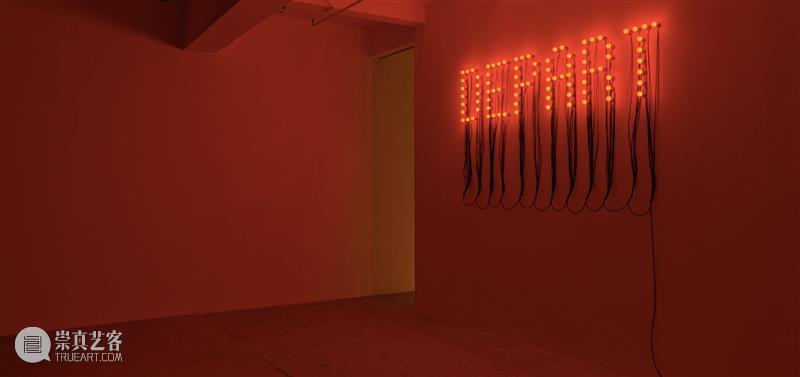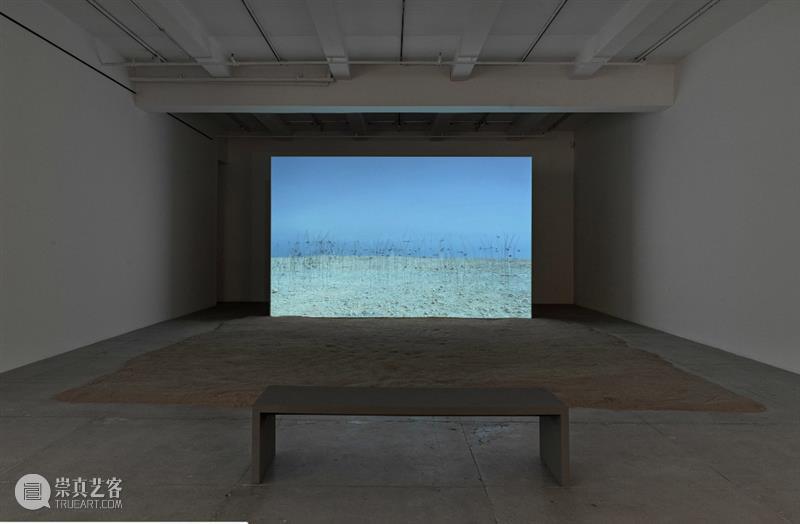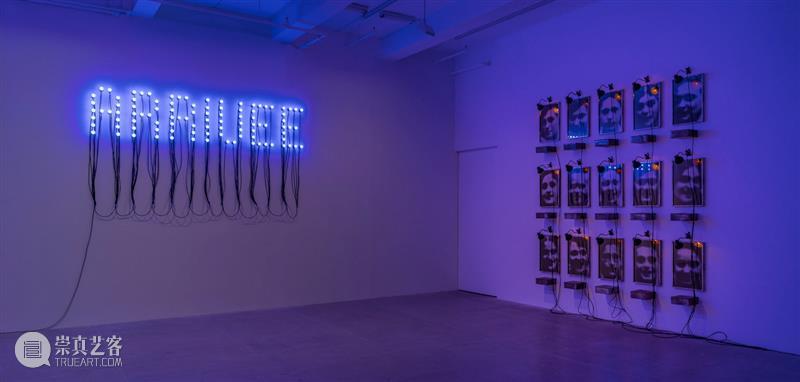
{{sindex}}/{{bigImglist.length}}


克里斯蒂安 · 波尔坦斯基
出发 - 到达
2022.09.13-10.15

玛丽安 · 古德曼画廊很高兴举办克里斯蒂安 · 波尔坦斯基的个展“出发 - 到达”,其中包括首次在美国展出的雕塑作品和影像装置,以及几件1980年代的历史作品。展览大部分源自波尔坦斯基本人2021年去世前的构思,这既是对他的一生以及创作的致敬,也令人一览驱使他50多年艺术实践的形而上学式思考。展览展现了波尔坦斯基表现时间流逝和人的存在的脆弱性的能力,以及他作为一个不受限的故事讲述者的强大技能。展览汇集了两个不同时期的作品,展示了艺术家多年来是如何在作品的物质性之外,逐渐专注于创造隐喻。

克里斯蒂安 · 波尔坦斯基个展现场,玛丽安 · 古德曼纽约画廊,2022

从2000年代初到2021年,波尔坦斯基越来越多地转向影像,创作了十多个影像装置,包括《Animitas》(灵魂)系列。该系列最初于2014年在智利的阿塔卡玛沙漠实现,并在世界其他地方(加拿大、日本和以色列)“重现”。在每处展示地点,由数百个日式风铃组成的雕塑作品描绘了1944年9月6日(波尔坦斯基的出生日期)天空中星座的确切分布。在风的吹拂下,铃声回响构成轻柔的协奏,如同在悼念飘荡的灵魂。这四件场域特定装置本身在展出过后便不复存在,但留存下的影像源自从日出到日落的长时间拍摄,使艺术家得以讲述曾短暂存在过的作品的故事。对于波尔坦斯基来说,这和他过去作品中使用二手衣或收集的老照片如出一辙:“当其它任何东西都没有保留下来时,这些影像便是对回忆的提示”。
在画廊北展厅,《Animitas(死去的母亲)》(2017)瞬间将我们带到了以色列的死海岸边。装置结合了影像投影和铺满地面的沙砾,仿佛宁静的沙漠景观的延续,并将参观者引入一种冥想状态。

克里斯蒂安 · 波尔坦斯基 / 《黄昏(暮光)》,2015 / 灯泡,灯座,黑色电线 / 尺寸可变
走到相邻的放映室,从门口便可看到由99个灯泡组成的《黄昏》(2015)。这件作品每天会有三个灯泡熄灭,如同是对展览期限的倒计时。展出第一天明亮而耀眼的展厅逐渐变暗,直到最后一天灯光完全消失。
“……故事比实物更有力量”,是艺术家2019年曾说过的话。巴黎蓬皮杜艺术中心波尔坦斯基回顾展的画册中记录了他在一次采访中的回答:“我的生命中存在着几个阶段:其中一个是作品存在的阶段;另一个是它们被摧毁然后重新创造的阶段;现在,重要的不再是看见作品,而是知道它们存在。这将是要被讲述下去的故事。”

克里斯蒂安 · 波尔坦斯基 / 《潜意识》,2020 / 4频影像装置,有声,循环播放 / 尺寸可变
画廊南展厅中的沉浸式影像装置作品《潜意识》(2020)是艺术家最后的创作之一,投映在四块大型幕布上。“一组非常俗套的影像展现了一种虚构的幸福幻象,其下却掩藏着有关众多恐怖暴行的潜意识图像。这些事件发生在我出生的世纪,和我的部分人生平行演进”,艺术家如此解释道。

克里斯蒂安 · 波尔坦斯基个展现场,玛丽安 · 古德曼纽约画廊,2022
在展厅的三楼,《到达》(Arrivée)的蓝色字母预示着一个新的开始。这里展出了一系列艺术家1980年代的开创性作品,包括《罐头盒-普弭节》(1987)、《夏斯高中》(1987)和《纪念碑》系列的两件作品。1980年代中期是波尔坦斯基创作生涯的转折点,他最知名的一些创作主题均源于这一时期:回忆与失去、生与死。在这里,展览空间变成了一个剧场,参观者处于直接的情感状态。

艺术家早期作品的美学特征在于他使用的材料(生锈的饼干锡盒,黑白照片搭配灯泡或小黑灯),以及对黑暗和阴影氛围的运用。在不提及任何特定宗教的情况下,作品让人联想到祭坛和墓碑。儿童或青少年的照片通常取自集体合照,例如波尔坦斯基自己1951年在学校的照片。《夏斯高中》创作于1987年,其中的人像源自1931年维也纳犹太夏斯高中的集体照片。
关于艺术家

克里斯蒂安 · 波尔坦斯基 / 摄影:Didier Plowy
近年为他举办过个展的机构包括韩国釜山美术馆(2021),巴黎蓬皮杜艺术中心(2019),路易威登东京文化艺术空间(2019),大阪国立美术馆及东京国立美术馆(2019),耶路撒冷以色列博物馆(2018),上海当代艺术博物馆(2018),阿根廷布宜诺斯艾利斯国立艺术博物馆(2017),意大利博洛尼亚现代艺术博物馆(2017),墨西哥蒙特雷当代艺术博物馆(2016),西班牙瓦伦西亚现代艺术学院(2016),比利时大奥尔尼当代美术馆(2015)以及智利圣地亚哥国家美术馆(2014)。
克里斯蒂安 · 波尔坦斯基曾获得的奖项中,包括2001年的“凯撒林奖”,以及2006年的“高松宫殿下纪念世界文化奖”。他曾参加1977年和1972年的卡塞尔文献展,并多次参加威尼斯双年展(2015、1995、1993、1980及1975)。2021年在他去世几个月之后,巴黎的三所重要机构:凡尔赛宫、卢浮宫、蓬皮杜艺术中心,以及巴黎喜剧歌剧院联合举办了展览向艺术家致敬,


Christian Boltanski: Départ - Arrivée
13 September - 15 October 2022

Marian Goodman Gallery is pleased to present Départ – Arrivée, a solo presentation by Christian Boltanski. The exhibition will feature recent sculptural works and video installations that have never been presented before in the U.S., as well as a selection of historical pieces from the 1980s. Mostly conceived by Boltanski himself before his passing in July 2021, the show is an homage to his life and work, offering a lens into the metaphysical preoccupations that drove his artistic practice for over fifty years. The exhibition reflects Boltanski’s ability to suggest the passage of time and the precariousness of our existence as well as his powerful skill as a universal storyteller. Bringing together works from two different time periods, the exhibition demonstrates how the artist, throughout the years, had become more and more interested in creating parabolas beyond the materiality of his works.
In the North Gallery, the word Départ in red lightbulbs greets the visitor and marks the debut of a journey through the exhibition towards Arrivée in blue located on the third floor. Presented for the first time at Galerie Marian Goodman, Paris in 2015, the diptych Départ – Arrivée (2015), echoes the voyage of life and has since become an iconic piece, included in his important retrospectives in Korea, France, Japan, and Israel.
From the early 2000s to 2021, Boltanski increasingly turned to video, creating more than a dozen video installations including the series Animitas, initiated in 2014 in the Atacama Desert in Chile and “re-played” in other parts of the world (Canada, Japan, and Israel.) At each site, a sculptural work made up of several hundreds of small Japanese bells mapped the exact configuration of the sky on September 6, 1944, Boltanski’s date of birth. Stirred by the wind, the bells resound like soft chimes as a tribute to drifting souls. Meant to be ephemeral, at each of Boltanski's four site-specific installations, the work is solely comprised of a long sequence shot from sunrise to sunset, enabling the artist to tell the story of its impermanent existence. For Boltanski, like the second-hand clothes or the found photographs used in his past works, “the films will serve as a reminder when nothing else remains.”
In the North Gallery, Animitas (Mères Mortes) (2017) momentarily brings us to the shores of the Dead Sea in Israel. The installation combines a video projection and a bed of gravelly sand to convey the continuation of the quiet desert landscape, inviting visitors to enter a meditative state.
In the adjacent viewing room, Crépuscule (2015), composed of 99 light bulbs, is viewable from its threshold. The floor piece functions as a countdown for the days of the show, fading away at the rhythm of three light bulbs each day. The room, bright and dazzling on the first day of the show, gradually becomes dark, resulting in the complete extinction of light.
“(…) Stories have greater power than objects,” explained Boltanski in 2019. “There have been several periods in my life; one where works existed, another where they had been destroyed but re-created, and now, it’s no longer about seeing the works but knowing they exist. This is the story that will have been passed on,” he continued in an interview published in his retrospective catalogue from Centre Pompidou in Paris.
In the South Gallery, the immersive video installation Subliminal (2020), is one of the last artworks created by the artist. The installation spreads over four large projections on which “cliché videos of a fabricated vision of happiness hide subliminal images of the horrors that took place in the century I was born into and that unfolded in parallel to part of my life,” explained the artist.
The blue letters of Arrivée indicate a new beginning as the exhibition continues onto the third floor with a selection of seminal works from the 1980s, including Réserve La Fête de Pourim (1987), Lycée Chases (1987) and two works from the Monument series. The mid-1980s was a turning point in Boltanski’s in which he developed the themes for which he is best known: the evocation of memory and loss, life and death. The exhibition space becomes a theater in which visitors are placed in direct state of emotion.
The aesthetics of this earlier decade of work is characterized by the materials employed by Boltanski (rusty biscuit tin boxes, black and white photographs paired with lightbulbs or small black lamps) as well as by atmosphere of darkness and shadows. Without referring to any specific religion, the works are reminiscent of altars and funerary monuments. The photographic portraits of children or teenagers are usually taken from group pictures such as Boltanski’s own school photo from 1951. Lycée Chases dates back from 1987 and includes a found group photograph of the Jewish Chases High School in Vienna from 1931.
About the artist
Christian Boltanski (1944 – 2021) was born in Paris during World War II to a Jewish father and a Catholic mother. He spent his childhood hearing stories of the Holocaust, which deeply influenced him. A self-taught artist, he began modeling clay and painting before developing his more conceptual work in the late 1960s. Since his first solo exhibition in Paris in 1968, his oeuvre has been widely shown internationally. In 1988-1989, Christian Boltanski: Lessons of Darkness was his first in-depth exhibition in the U.S., co-organized by MOCA, the Museum of Contemporary Art, Chicago; and The New Museum of Contemporary Art, New York, and presented at the Vancouver Art Gallery; the University Art Museum, Berkeley; and The Power Plant, Toronto. In 2010, his monumental project No Man’s Land was presented and reenacted in three locations, Grand Palais in Paris, Hangar Bicocca in Milan, and Park Avenue Armory in New York. In 2011 he represented France at the 54th Venice Biennale.
Recent solo shows have been held at Busan Museum of Art, Korea (2021); Centre Pompidou, Paris, France (2019); Espace Louis Vuitton, Tokyo, Japan (2019); The National Museum of Art, Osaka, Japan and the National Art Center, Tokyo, Japan (2019); The Israel Museum, Jerusalem (2018); The Power Station of Art, Shanghai, China (2018); Museo Nacional de Bellas Artes, Buenos Aires, Argentina (2017); Museo d'Arte Moderna di Bologna, Italy (2017); The Museum of Contemporary Art of Monterrey, Mexico (2016); Instituto Valenciano Arte Moderno (IVAM), Spain (2016); Mac's Grand Hornu, Belgium (2015); and Museo Nacional de Bellas Artes, Santiago, Chile (2014).
Boltanski was honored with several awards over his lifetime, including the Praemium Imperiale Award (2006) and the Kaiser Ring Award (2001). He participated in Documenta (1977 and 1972) and numerous Venice Biennales (2015, 1995, 1993, 1980 and 1975). In October 2021, a few months after he passed away, three prestigious French institutions in Paris; the Palace of Versailles, the Musée du Louvre; the Centre Pompidou, with the Opéra Comique, organized a joint homage to the artist.

PRINTED EDITIONS AND MULTIPLES(1967-1977)
Tuesday - Saturday, 11 am - 6 pm
&
GERARD KELLY
PANORAMA


Instagram:mariangoodmangallery
{{flexible[0].text}}


Find Your Art
{{pingfen1}}.{{pingfen2}}
吧唧吧唧
加载更多
已展示全部
{{layerTitle}}
使用微信扫一扫进入手机版留言分享朋友圈或朋友
长按识别二维码分享朋友圈或朋友
{{item}}
编辑
{{btntext}}
继续上滑切换下一篇文章
提示
是否置顶评论
取消
确定
提示
是否取消置顶
取消
确定
提示
是否删除评论
取消
确定
登录提示
还未登录崇真艺客
更多功能等你开启...
更多功能等你开启...
立即登录
跳过
注册





 分享
分享